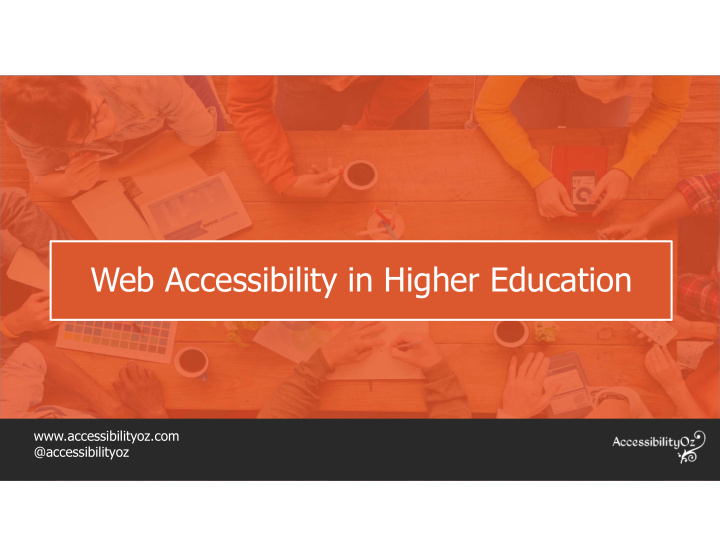



Web Accessibility in Higher Education www.accessibilityoz.com @accessibilityoz
Dyslexia Moderate vision impairment Epilepsy Migraines Severe vision impairment Physical impairment
It’s not just about vision impairments
Our Services Audits User testing Mobile testing OS / browser testing Building web sites Consultation CMS testing Accessible documents Accessible design Video accessibility @accessibilityoz
Our Products OzPlayer More information: www.accessibilityoz.com OzART OzWiki @accessibilityoz
Overview of accessibility gian@accessibilityoz.com accessibilityoz.com
What is online accessibility? Online accessibility: — ability for a person with a disability to understand and use a web site, application, intranet, or program Governed by: — AHRC Disability Discrimination Act Achieved by: — W3C Web Content Accessibility Guidelines (WCAG) @accessibilityoz
Accessibility is important… It allows people with disabilities to: access information like anyone else • interact with others without being categorised as • “disabled” undertake activities which they are not otherwise • able to do @accessibilityoz
People with disabilities gian@accessibilityoz.com accessibilityoz.com
How many people? gian@accessibilityoz.com accessibilityoz.com
People with disabilities What disability types are assisted by an accessible website? Disabilities affecting vision Disabilities affecting how the mind interprets information Disabilities affecting movement Disabilities affecting hearing @accessibilityoz
Legal precedents June 1999 – August 2000 Bruce Maguire lodged a HREOC complaint about the Sydney Olympics web site HREOC ruled in Maguire’s favour September 2000 SOCOG ignored HREOC and fined $20,000 Legal fees greater than $500,000 @accessibilityoz
Accessibility litigation - US Target.com $6 million class action suit, legal fees in excess of $3.5 million Government of Canada Make all of their web sites accessible within 15 months Netflix $795,000 in damages and captions within 2 years. They reached 100% of content captioned in December 2014 @accessibilityoz
Web Content Accessibility Guidelines Principles, Guidelines, Success criteria, Techniques and Conformance levels gian@accessibilityoz.com accessibilityoz.com
WCAG Developed by the W3C: Written by: International, vendor- Accessibility specialists neutral organisation People with disabilities Version 1: 1999 Software vendors Version 2: 2008 @accessibilityoz
About WCAG2 Four Principles Layout of a Principle: Perceivable Each Principle has Guidelines Operable Each Guideline has Understandable Success Criteria Robust Each Success Criteria has Sufficient, Advisory and Failure Techniques @accessibilityoz 17
Conformance levels Three conformance levels: Level A (minimum) Level AA (medium) Level AAA (maximum) Conformance (and conformance level) is for full Web page(s) only, and cannot be achieved if part of a Web page is excluded. @accessibilityoz
Web Accessibility in Higher Education gian@accessibilityoz.com accessibilityoz.com
Why is accessibility different for higher ed? Higher education: • Many disparate units, doing many different things • All types of technology, e-commerce, etc • Teeny-tiny budgets! @accessibilityoz
What about when there’s no budget?
WANAU https://wanau.org/ gian@accessibilityoz.com accessibilityoz.com
Accessibility Factsheets Everything you need to know about accessibility gian@accessibilityoz.com accessibilityoz.com
Presentations, articles, slideshows Conferences: a11yoz.com/conferences Presentations: a11yoz.com/presentations Articles: a11yoz.com/articles @accessibilityoz
If you have a teeny-tiny budget
OzWiki Real accessibility examples gian@accessibilityoz.com accessibilityoz.com
OzART Manage your testing and fixes in the same place gian@accessibilityoz.com accessibilityoz.com
Accessibility Roadmap Map out what you need to do gian@accessibilityoz.com accessibilityoz.com
Phase A: Quick wins 1. Build an accessibility committee 2. Develop Disability Reference Group 3. Appoint an accessibility champion 4. Hire additional Disability Services staff 5. Address accessibility issues identified in the Accessibility Stocktake 6. Develop accessibility resources 7. Provide a communication method for staff and students to comment on accessibility @accessibilityoz
Phase B: Develop an Accessibility Plan 1. Write an Accessibility Statement 2. Develop an Accessibility Action Plan 3. Add Accessibility to University Policies and Procedures 4. Communicate the Accessibility Plan, changes to University Policies and Procedures @accessibilityoz
Phase C: Make accessibility fixes 1. Ensure all future University web sites and applications are accessible 2. Create an inventory of ICT (software, websites, classroom technologies, videos) 3. Identify web sites and applications to be tested 4. Conduct testing 5. Contact vendors 6. Undertake fixes @accessibilityoz
Phase D: Develop accessibility knowledge in Uni 1. Provide training for web staff, Faculty and Disability Services 2. Run frequent Accessibility sessions 3. Develop case studies @accessibilityoz
Questions? Come see us at our exhibit booth to discuss your needs gian@accessibilityoz.com accessibilityoz.com
Recommend
More recommend